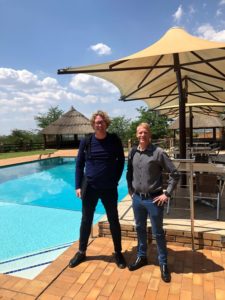
Jared and Craig, Johannesburg 2018
This November the Retail Smart UK Office went to visit Retail Smart in South Africa located in Johannesburg. Instead of having meetings in an office in rainy England, these meetings were set next to the pool in the sun which was a welcome change for the UK team.
Part of the aim of the visit was to continue our research into the differences between the South African and English retail market. We visited a large variety of retailers and conducted multiple side visits to their retail stores to understand the state of space planning in South Africa. It was interesting to see the differences and similarities between the two markets and how we can learn from each other.
We would like to share some of our main outcomes:
- The majority of retailers in the UK use some kind of space planning software, however this is not the case in South Africa. The difference between retailers in South Africa that do space planning and the retailers that don’t, is immediately visible in their stores. The stores of retailers that do not plan their space lacked a consistent layout between their stores. We found that there was a clear disconnection between various branches of the same retailers in the way the store was laid out from the entrance right through the retail space. The flow of departments/categories as we walked through the store would vary and one could hardly tell that we were shopping at the same retailer. It is key to distinguish your brand as a retailer by replicating each branch/store to have the same store layout, look and feel. Floor space does vary, and markets do too, but as a retail chain this is important for brand recognition.
- Out of stocks on shelf were an indicator of category management challenges, we all know that manufacturers and suppliers do run out of stock from time to time but in most cases we could tell that these were replenishment issues from a buying perspective as other retailers did have stock of certain items others did not. We found that in cases where space planning and category management software was used for replenishment purposes out of stocks were minimal.
- The flow of products and product categories made it challenging to shop each category as a consumer and we found that we had to browse from shelf to shelf in search of PI (price indicator) labels that matched the products we were shopping for. There seemed to be a lack of categorization and good merchandising practices where ranges of products were concerned, for instance, the pricing flow of certain ranges ran from premium to base from left to right in one range of products and vice versa in another, these were of two household appliance product ranges merchandised alongside each other. This was an indication of a lack of planograms set out for merchandisers to follow. Planogramming software eases this procedure and eliminates poor merchandising standards.
- Hot Spot areas are a large profit generator in the U.K market, these areas are earmarked by category managers with the use of space planning software as key touch points for shoppers to pass by when shopping within a high traffic area of the store, these hot spots are generally used for merchandising of high profit margin products which are mostly impulse purchases and have shown to be greatly successful. We found that there was an opportunity for this in a few of the retailers we visited and some used this method quite successfully.
